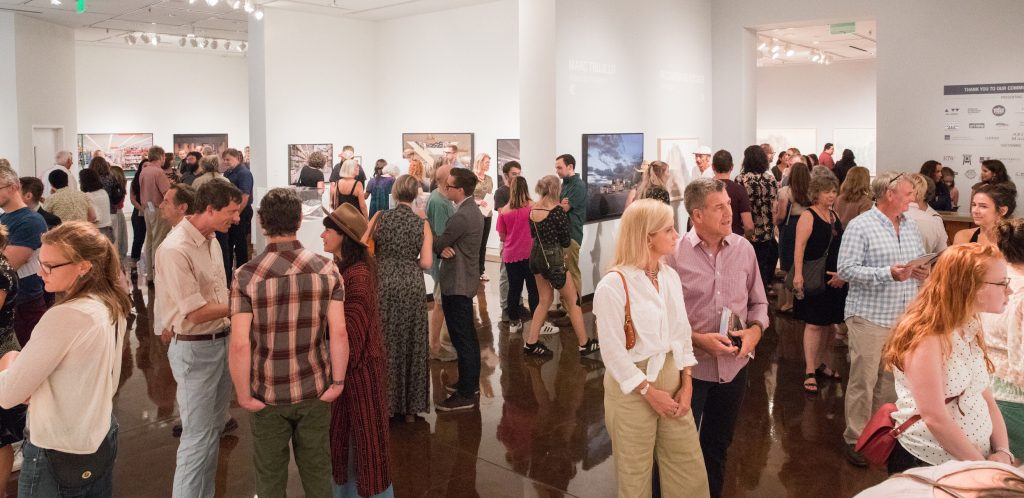

This exhibition of three contemporary photographers explores the contested terrain between man and the natural landscape in several locations around the globe. Exploiting photography’s power to entice the viewer, these images reflect both the beauty and the fragility of the earth, while illuminating seldom-seen landscapes currently under siege.
The term “no man’s land” was first used to describe the ground between two opposing trenches during World War I, and implied that neither side in the conflict was safe in this zone. There is a kind of trench warfare being carried out now between the environment and human presence. Environmentalists have long been sounding the alarm on the destructive (and often irreversible) effects of large-scale manufacturing, mining, munitions testing, and quarrying, but there is now a more global awareness of the injuries we as a species are inflicting on our planet. Politicians are being lobbied by multi-national corporate conglomerates to set policy favorable to their business interests, while small, non-profit environmental and watchdog organizations are slinging stones in an effort to draw attention to these important issues.
Historically, photographers have been instrumental in communicating the plight of wilderness under the pressure of humans, sometimes inadvertently. In the nineteenth century, photographers Eadweard Muybridge, Carleton Watkins, Timothy O’Sullivan, and William Henry Jackson provided clear-eyed vistas from the pristine American West. Their photographs helped transform what was terra incognita into fuel for heady dreams of westward expansion. Photographer Darius Kinsey showed the effects of the logging industry on the Pacific Northwest from the turn of the century until the 1940s, yet his motivation at the time was not as a conservationist. Similarly, Ansel Adams’ dramatic images were used in the service of the Sierra Club to effect national policy toward wilderness. This feat was due in large part to the power of photography in general, and Adams’ imagery in particular, to communicate the majesty of natural subjects. It is interesting that few of Adams’ photographs contain evidence of humans or human habitation. His was a poetic vision, if not an idealized one, yet his work remains the pivot point between the early landscape photographers and those working today.
In Adams’ footsteps follow a succession of photographers who have chosen to take up the mantle of landscape photography. To list a few, William Garnett, Peter Goin, Richard Misrach, Lewis Baltz, Linda Connor, JoAnn Verberg, Mark Klett, Robert Dawson, Karen Halverson, Len Jenschel, Dianne Cook, Michelle Van Parys, and Robert Adams have each provided extended meditations on the effects of human presence as evidenced in the American landscape.
The “New Topographics” exhibition at the George Eastman House in 1975 provided a radical break from the tradition of photographers rehashing art historical concepts of the sublime landscape. These photographers avoided the dramatic and magnificent in favor of the vernacular and industrial. Their style was cool. Most of the images in the project reflect an almost sterile “objectivity” which allowed for a more complex reading of our interactions with the natural order. One of the results of their efforts was to reinvigorate the debate about the role of photography and art in social policy that had lagged since the days of the Farm Security Administration in the 1930s.
“The Rephotographic Survey Project” in the late 1970s was another seminal event to be noted in this brief lineage of “concerned” landscape photography. Using logbooks and diaries as their sources, the artists included in this ambitious undertaking set about finding the veritable tripod holes used by the nineteenth-century photographers who first chronicled the Amer-ican West 100 years prior for the U.S. Geological Survey.(2)The resulting pairings of photos taken in the same location, time of day, date, and format 100 years apart collapse two slices of history into a single field of view. This small revolutionary idea has spawned a host of other “rephotographic” projects around the world.
Landscape photographers Edward Burtynsky, Emmet Gowin, and David Maisel are each well established within the medium. Though their bodies of work do not constitute a movement, this exhibition is intended to present a complicated version of the state of the environment through their photographs. The artists’ works draw our attention to the precarious yet interdependent nature of our relationship with the Earth. In-itially, their works draw us in by the seductive beauty of the photographic print itself. It is only after this initial reading that we begin to apprehend the content of each image. Not only is the content of each of these individual images troubling, we now must try to reconcile the aggregate effect of so much devastation.
Witnesses to the first atomic bomb blast at the Trinity Site in Jornada del Muerto, New Mexico on 16 July 1945, described the event as having a “terrible beauty,” a phrase borrowed from W. B. Yeats. Similarly, Edward Burtynsky’s photos of truck-tire heaps, or Emmet Gowin’s Test Site photos, or the toxic poison ponds of David Maisel’s imagery simultaneously evoke a sense of dread and aesthetic fascination. To quote David Maisel from his book “The Lake Project,” referring to Owens Lake in California: “If death is the Mother of beauty, as the poet Wallace Stevens said, then these images may serve as the lake’s autopsy.” The photographers in this exhibition invite us to consider our complicity in creating these forbidding “no-man’s lands” through our attempts to control nature for our own desires